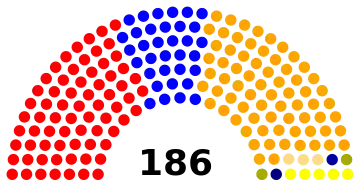| |||||||||||||||||||||||||||||||||||||||||||||||||||||||||||||||
All 186 seats in the Chamber of Representatives All 93 seats in the Senate | |||||||||||||||||||||||||||||||||||||||||||||||||||||||||||||||
This lists parties that won seats. See the complete results below.
| |||||||||||||||||||||||||||||||||||||||||||||||||||||||||||||||
General elections were held in Belgium on 16 November 1919.[1] Although the Belgian Labour Party received the most votes in the Chamber of Representatives elections, the Catholic Party remained the largest party in both the Chamber and the Senate.[2] Voter turnout was 88.5% in the Chamber elections.[3]
They were the first elections after the First World War, and the first with universal single-vote suffrage (for men), a change that was sought by and benefited the Belgian Labour Party. The voting age was also lowered from 25 to 21, and the system of proportional representation was modified to use apparentment (combining votes of different arrondissements within a province).
Results
Chamber of Representatives
 | ||||
|---|---|---|---|---|
| Party | Votes | % | Seats | |
| Belgian Labour Party | 645,124 | 36.62 | 70 | |
| Catholic Party | 619,911 | 35.19 | 70 | |
| Liberal Party | 310,876 | 17.65 | 34 | |
| Frontpartij | 60,814 | 3.45 | 5 | |
| Catholic dissidents | 36,063 | 2.05 | 3 | |
| Middle Class Party | 19,939 | 1.13 | 1 | |
| Combatants | 19,075 | 1.08 | 2 | |
| National Renaissance | 18,546 | 1.05 | 1 | |
| Christene Volkspartij | 5,825 | 0.33 | 0 | |
| Socialist dissidents | 1,181 | 0.07 | 0 | |
| Other parties | 24,446 | 1.39 | 0 | |
| Total | 1,761,800 | 100.00 | 186 | |
| Valid votes | 1,761,802 | 94.68 | ||
| Invalid/blank votes | 99,088 | 5.32 | ||
| Total votes | 1,860,890 | 100.00 | ||
| Registered voters/turnout | 2,102,710 | 88.50 | ||
| Source: Nohlen & Stöver, Belgian Elections[lower-alpha 1] | ||||
Senate
 | ||||
|---|---|---|---|---|
| Party | Votes | % | Seats | |
| Catholic Party | 685,041 | 43.30 | 43 | |
| Liberal Party | 490,046 | 30.98 | 30 | |
| Belgian Labour Party | 388,011 | 24.53 | 20 | |
| Middle Class Party | 10,601 | 0.67 | 0 | |
| National Union | 5,245 | 0.33 | 0 | |
| National Renaissance | 3,068 | 0.19 | 0 | |
| Total | 1,582,012 | 100.00 | 93 | |
| Registered voters/turnout | 2,102,710 | – | ||
| Source: Belgian Elections | ||||
Constituencies
The distribution of seats among the electoral districts was as follows:[4][5]
| Province | Arrondissement(s) | Chamber | Senate |
|---|---|---|---|
| Antwerp | Antwerp | 15 | 7 |
| Mechelen | 5 | 5 | |
| Turnhout | 4 | ||
| Elected by the provincial council | 3 | ||
| Limburg | Hasselt | 3 | 4 |
| Tongeren-Maaseik | 4 | ||
| Elected by the provincial council | 2 | ||
| East Flanders | Aalst | 5 | 4 |
| Oudenaarde | 3 | ||
| Gent-Eeklo | 12 | 6 | |
| Dendermonde | 4 | 4 | |
| Sint-Niklaas | 4 | ||
| Elected by the provincial council | 4 | ||
| West Flanders | Bruges | 4 | 2 |
| Roeselare-Tielt | 5 | 3 | |
| Kortrijk | 5 | 4 | |
| Ypres | 3 | ||
| Veurne-Diksmuide-Ostend | 5 | 2 | |
| Elected by the provincial council | 3 | ||
| Brabant | Leuven | 7 | 3 |
| Brussels | 26 | 13 | |
| Nivelles | 4 | 2 | |
| Elected by the provincial council | 4 | ||
| Hainaut | Tournai-Ath | 6 | 3 |
| Charleroi | 11 | 7 | |
| Thuin | 3 | ||
| Mons | 7 | 5 | |
| Soignies | 4 | ||
| Elected by the provincial council | 4 | ||
| Liège | Huy-Waremme | 4 | 2 |
| Liège | 13 | 7 | |
| Verviers | 5 | 2 | |
| Elected by the provincial council | 3 | ||
| Luxembourg | Arlon-Marche-Bastogne | 3 | 3 |
| Neufchâteau-Virton | 3 | ||
| Elected by the provincial council | 2 | ||
| Namur | Namur | 5 | 5 |
| Dinant-Philippeville | 4 | ||
| Elected by the provincial council | 2 | ||
| Total | 186 | 93 + 27 | |
Notes
- ↑ The number of valid votes is two higher than the number of votes cast for parties
References
- ↑ Dieter Nohlen & Philip Stöver (2010) Elections in Europe: A data handbook, p289 ISBN 978-3-8329-5609-7
- ↑ Nohlen & Stöver, pp308-310
- ↑ Nohlen & Stöver, p290
- ↑ List of members of the Chamber of Representatives (1919-1920)
- ↑ List of members of the Senate (1919-1920)